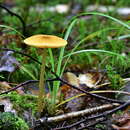en
names in breadcrumbs


Guidance for identification (German text)
Pluteus leoninus, commonly known as lion shield, can occasionally be found growing on dead wood in Europe and North Africa. The underside of the cap is typical of the genus Pluteus — the gills are pale, soon becoming pink when the spores ripen. But the upper surface is a bright tawny or olivaceous yellow. The species name leoninus (meaning leonine) refers to this cap colour.
This description is combined from several references.[1][2][3][4]
Many authorities consider Pluteus fayodii to be a synonym of P. leoninus,[5][2][6] but according to Species Fungorum, they are distinct.[7]
According to some sources,[8][9] it is edible but has little to no taste.
Pluteus leoninus, commonly known as lion shield, can occasionally be found growing on dead wood in Europe and North Africa. The underside of the cap is typical of the genus Pluteus — the gills are pale, soon becoming pink when the spores ripen. But the upper surface is a bright tawny or olivaceous yellow. The species name leoninus (meaning leonine) refers to this cap colour.